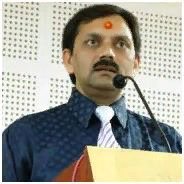
Dwivedi Ved Vyas
Work place: C. U. Shah University, Electronics Communication Engineering, Wadhwan City, 363030, India
E-mail: provc.cushahuniv@gmail.com
Website:
Research Interests: Engineering, Computational Engineering
Biography
Dr. Ved Vyas Jayprakash Narayan Dwivedi born in 1974 is a renowned educationist, academic manager and core researcher having wide spread experience for imparting education and managing the educational organizations in and around this district and across Gujarat state. He had been serving as Pro-Vice-Chancellor C. U. Shah University Wadhwan City, Gujarat India. He earned his Bachelor of Engineering, Master of Engineering and Doctor of Philosophy, all in Electronics and Communication Engineering. His academic interest is in energy-sensor-wireless-mobile-RF-antenna-microwave technology and sciences. He has published/authored/co-authored 9 books, 133 research/review articles/papers in refereed international/national journals/conference proceedings, successfully guided 5 Ph.D. theses (awarded), examined and reviewed 9 Ph.D. theses. He has 4 Indian patents in his name and applied for 01 Indian patent, completed 7 research and industry consultancy based projects, delivered 38 expert and key notes talks, guided and examined 54 M. Tech. dissertations. He has been honoured with being the Chief Guest / Guest of Honour on more than 37 occasions in national/international conferences, seminars, workshops, STTP and annual functions or social events.
Author Articles
Real Time Depth Data Refurbishment in Frequency Domain and 3D Modeling Map Using Microsoft Kinect Sensor
By Kapil S. Raviya Dwivedi Ved Vyas Ashish M. Kothari
DOI: https://doi.org/10.5815/ijigsp.2016.11.07, Pub. Date: 8 Nov. 2016
The present decade has seen the growth of both, the software and hardware for three dimensional televisions in real time applications. Depth map is fundamental key of 3-Dimensional algorithms. Reliable depth map is an acceptance in 3D transmission, analysis and compression of algorithm. Computer vision and pattern recognition research fields use sensor like low cost Microsoft kinect. Kinect sensor suffers from some problems of noise, poor accuracy and unmatched edges. This paper presents effective solution to improve the real time depth sequences and real time 3-D map using warping method from kinect sensor.
We proposed real time frequency domain based depth data refurbishment and improve the quality of depth video provided by sensors' Microsoft Kinect. The quality of the depth map is improved by depth refurbishment in frequency domain technique, filling the holes present in the maps, 2-Dimensional spatial filtering and permutation of morphological operation. We show that the proposed approach is able to generate high quality depth maps which can be quite useful in improving the performance of various applications of Microsoft Kinect such as obstacle detection and avoidance, pose estimation, gesture recognition, skeletal and facial tracking, etc. We produce the real time 3-D map using warping method. An experimental result shows that the quality of our proposed method is better than previous research works. Our algorithm produces noise less, reliable, smooth and efficient depth sequence. The qualitative parameter Peak Signal to Noise Ratio (PSNR), Structure Similarity Index Map (SSIM) and Mean Square Error (MSE) measure the real time results for comparative analysis.
An Evaluation and Improved Matching Cost of Stereo Matching Method
By Kapil S. Raviya Dwivedi Ved Vyas Ashish M. Kothari
DOI: https://doi.org/10.5815/ijigsp.2016.10.06, Pub. Date: 8 Oct. 2016
The main target of stereo matching algorithms is to find out the three dimensional (3D) distance, or depth of objects from a stereo pair of images. Depth information can be derived from images using disparity map of the same scene. There are many applications of computer vision like People tracking, Gesture recognition, Industrial automation and inspection, Security and Biometrics, Three-dimensional modeling, Web and Cloud, Aerial surveys etc. There are large categories of stereo algorithms which are used for finding the disparity or depth. This paper presents a proposed stereo matching algorithm to obtain depth map, enhance and measure. The hybrid mathematical process of the algorithm are color conversion, block matching, guided filtering, Minimum disparity assignment design, mathematical perimeter, zero depth assignment, combination of hole filling and permutation of morphological operator and last non linear spatial filtering. Our algorithm is produce noise less, reliable, smooth and efficient depth map. We obtained the results with ground truth image using Structural Similarity Index Map (SSIM) and Peak Signal to Noise Ratio (PSNR).
[...] Read more.Other Articles
Subscribe to receive issue release notifications and newsletters from MECS Press journals